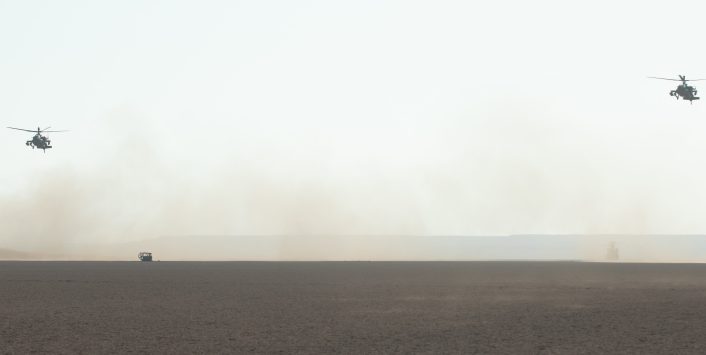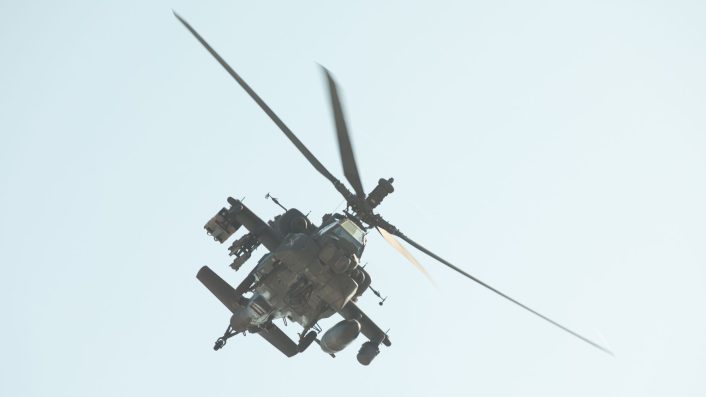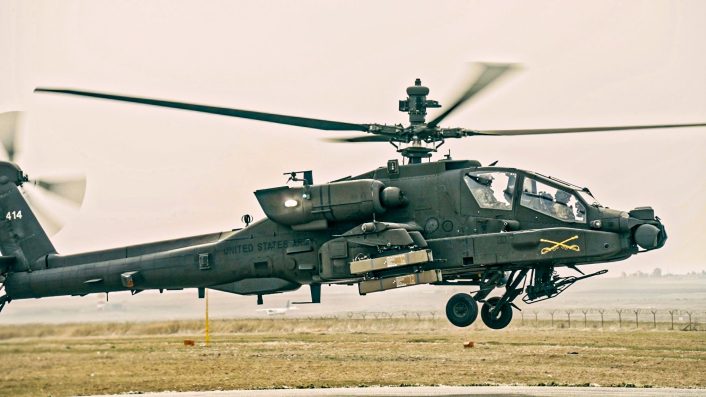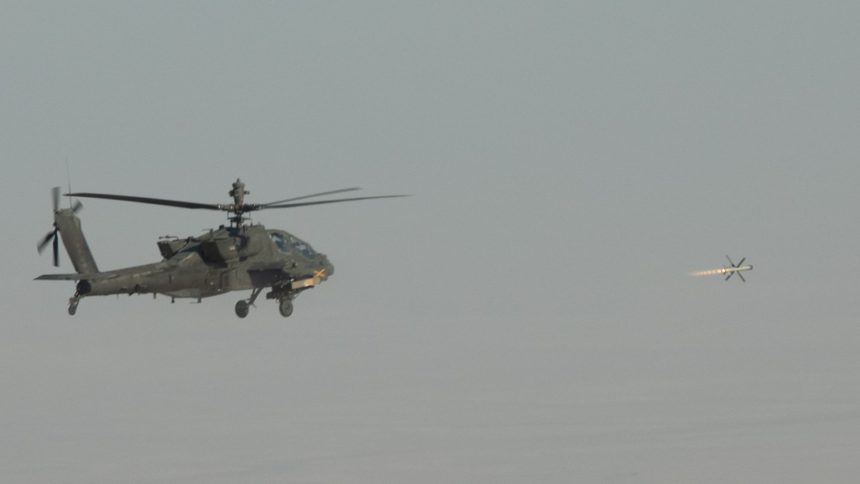The first live shoot of the Spike NLOS by a conventional aviation unit shows Apache crews can conduct extended-range precision strikes against targets obscured by terrain or distance.
U.S. Army AH-64E v6 Apache Guardian attack helicopters of the 101st Combat Aviation Brigade (CAB) fired for the first time a Spike NLOS (Non-Line of Sight) missile in the CENTCOM (Central Command) AoR (Area of Responsibility) on Aug. 27, 2025. According to images and information released on DVIDS on Aug. 29, the missile destroyed a vehicle that was used as a ground target for the demonstration.
The same day, the European theater also saw a Spike NLOS demonstration with AH-64Es of the 12th CAB firing two Spike NLOS missiles, successfully striking sea-based targets at ranges of up to 25 km (14 nautical miles). This test took place at the Central Air Force Training Range in Ustka, on Poland’s Baltic coast, and was supported by the Polish Air Force Inspector General Israeli firm Rafael Advanced Defense Systems, the developer of the Spike NLOS system.
The test in the CENTCOM AOR came four months after the U.S. Army released images of an AH-64E Apache from the 101st Airborne Division “Screaming Eagles” carrying at least two Spike NLOS on Mar. 5, 2025. The Spike NLOS is distinguished by rectangular box canisters and the Mar. 5 images show two missiles being carried only on the right-side stub wing.

Spike NLOS, AGM-114 Hellfire and AGM-179 JAGM
The Spike NLOS missile has four large fold-out fins for flight control and, according to Lockheed Martin – that has teamed up with Rafael Advanced Defense Systems to offer the weapon system to U.S. customers, is powered by an advanced rocket motor that takes it to a range of 32 km. Rafael says that the 32 km reach is attained when fired from land, but in an aerial stand-off configuration from a platform like the Apache – that Israel also uses – it can reach 50 km.
The missile can also be integrated with ground and maritime platforms, offering protection against fast moving USVs, land platforms, tactical armored systems and tanks, thanks to a dual electro-optical and infrared seeker. The weapon leverages its “stand-off capability to strike distant or geographically concealed targets without line-of-sight.”
View this post on Instagram
The weapon’s seeker and wireless datalink provide “real-time video imagery and man-in-the-loop control throughout the missile’s flight, granting “operators […] the opportunity to alter or abort the mission while en route to the target.” Rafael also mentions other “ground-breaking” features like “salvo controls, system hand-over, target acquisition, and extended ranges, that enables “rapid closure of sensor-to-shooter loops and neutralization of swarm attacks from significant stand-off ranges.”
The kinematics are more suited for fast-moving surface targets both on land and sea, representative of the threats U.S. and Allies are currently facing and would continue to face, such as Iranian and Houthi USVs and Chinese maritime fishing militias that are likely to swarm and confuse coalition assets.

On Jun. 26, 2024, a U.S. Marine Corps AH-1Z Viper from the 31st MEU (31st Marine Expeditionary Unit) sank a moving training target vessel in the Philippine Sea. Prior to that, on Apr. 30, 2024, an AC-130J Ghostrider, belonging to the 27th Special Operations Wing from Cannon Air Force Base, New Mexico, engaged a target vessel near Lubang, Philippines.
The test in Europe and the CENTCOM AOR means the Army is well on its way to field operationally the Israeli system – if it hasn’t already. The weapon was selected as an interim longer range alternative for the AGM-114 Hellfires and the AGM-179 JAGMs (Joint Air-to-Ground) missiles.
The JAGM and the enhanced range JAGM-MR (Medium-Range), with a range of 8 km/5 miles and 16 km/10 miles, respectively, are an evolution of the Hellfire and its most advanced version, the AGM-114R. The JAGM is based on the common Hellfire body but with a different motor and an additional near-infrared seeker, making it a tri-mode system.

Live fire in CENTCOM
The caption for the Aug. 26 event says the “first live shoot of the Spike NLOS by a conventional aviation unit […] provides Apache crews with an extended-range precision strike capability, allowing engagement of targets obscured by terrain or distance.” The caption further adds “the live fire validates the integration of the system and expands the Brigade’s ability to support Combined Joint Task Force – Operation Inherent Resolve regional security efforts.”
There was however no mention of the range at which the Spike NLOS was fired. One image shows two AH-64E v6 Apache Guardians from the 101st CAB conducting a post strike assessment following the employment of the Spike NLOS on the target ground vehicle, with both helicopters carrying two Spike NLOS each, but it is not clear how many weapons were employed.
🇺🇸🇵🇱🇮🇱 The United States Army, in cooperation with the Inspectorate of the Polish Air Force and with support from Rafael Advanced Defense Systems, conducted a live-fire demonstration of the SPIKE NLOS missile system at the Central Air Force Training Range in Ustka, Poland, Aug.… pic.twitter.com/vwFz8b2CLw
— Guy Plopsky (@GuyPlopsky) September 8, 2025
The test of the missile in that region suggests a continuing U.S. military presence there. This is especially relevant following the recurring confrontation with Iran, its aligned-militias and Israel’s hostility with Tehran, which is not expected to subside soon.
Relevance of Apache attack helicopters
It must be noted that the 12th CAB’s Spike NLOS/AH-64E test in Poland on Aug. 27 was also in a maritime environment, speaking to the emergence of attack helicopters in naval warfare. China is already examining the use of its Z-10 attack helicopters from military-controlled civilian semi-submersible platforms.
This could be to protect its offshore reclaimed bases in the South China Sea and for extended launches for operations against Taiwan. At the same time, it would also unburden China’s larger naval and naval aviation units from island-protection and maritime surveillance missions.
Watch as #USArmy AH-64E Apache Guardian attack helicopters employ the advanced #SPIKE NLOS missile system. This revolutionary capability expands combat potential and adds a new dimension of firepower for the U.S. Army in Europe.
U.S. Army video by Sergeant Jamie Robinson. https://t.co/15RXOS43HD pic.twitter.com/oFRleetyr6
— 𝔗𝔥𝔢 𝕯𝔢𝔞𝔡 𝕯𝔦𝔰𝔱𝔯𝔦𝔠𝔱△ 🇬🇪🇺🇦🇺🇲🇬🇷 (@TheDeadDistrict) September 3, 2025
In Poland’s case, Warsaw is one of the largest future operators of the AH-64E Apache, having committed to the acquisition of 96 helicopters under its Kruk (Raven) requirement. Deliveries are expected to begin in 2028 and continue through 2032.
In preparation, Polish crews are already training on leased U.S. Army AH-64D Apache Longbow helicopters. In June, the first three AH-64D Apaches, out of a total of eight, arrived at the 56th Air Base in Inowrocław.









